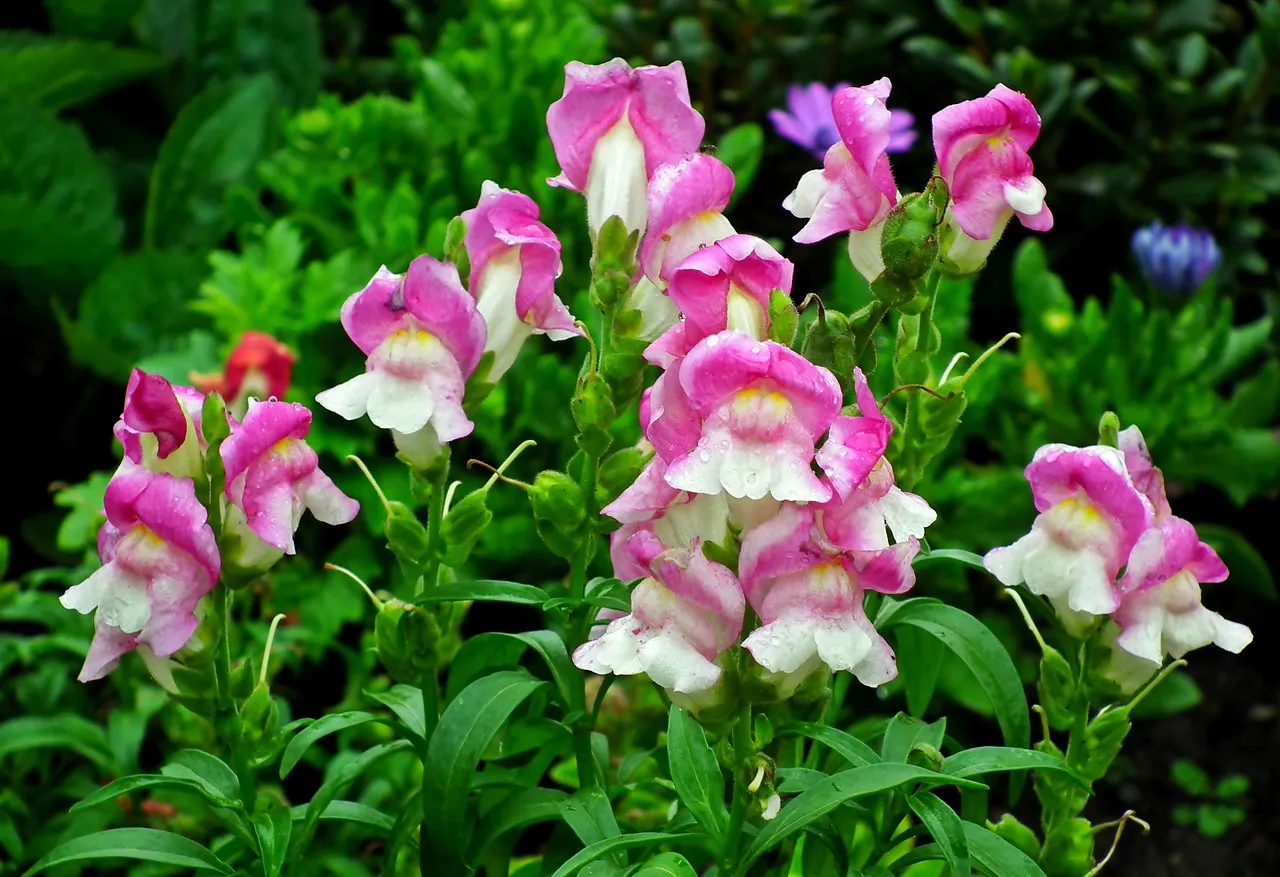Welcome to our comprehensive blog post, “The Ultimate Guide to Growing Snapdragon Flowers in Your Balcony Garden.” If you’re a gardening enthusiast looking to add a touch of vibrant beauty to your balcony space, then you’re in the right place! Snapdragons, with their charming, dragon-like blooms, are a delightful addition to any balcony garden, creating a colorful and lively atmosphere.
In this guide, we’ll walk you through everything you need to know to successfully grow and care for these enchanting flowers. From choosing the right varieties and planting techniques to nurturing them throughout their growth stages, we’ve got you covered with expert tips and insights. So, let’s roll up our sleeves and embark on an exciting journey to transform your balcony into a breathtaking oasis of Snapdragon blooms!

Types of Snapdragon Plants:
Following types of Snapdragon plants found:
Antirrhinum majus (Common Snapdragon):
The Common Snapdragon, or Antirrhinum majus, is a classic choice for balcony gardeners. Its tall, spiky blooms and various colors add elegance to any space. This variety prefers full sun exposure, perfect for sunlit balconies. Use well-drained potting soil to prevent drainage and root rot. Sow seeds or transplant after the last frost for growth. Regular deadheading promotes continuous blooming and pruning maintains tidiness. The Common Snapdragon is low-maintenance and attracts pollinators, enhancing garden biodiversity.
Antirrhinum braun-blanquetii (Pyrenean Snapdragon):
The Antirrhinum braun-blanquetii, also known as the Pyrenean Snapdragon, is a charming addition to any balcony garden. Native to the Pyrenees mountains, this variety is well-suited to cooler climates and can tolerate partial shade. The Pyrenean Snapdragon produces dainty flowers in soft pastel hues, creating a serene and peaceful ambiance. It requires well-draining soil and moderate watering to prevent waterlogging. Plant the seeds or transplants in early spring or late summer for optimal growth.
Deadheads are withered periodically to encourage the production of new buds. With its delicate beauty and adaptability to cooler conditions, the Pyrenean Snapdragon is an excellent choice for balcony gardeners looking to add a touch of mountain charm to their outdoor space.
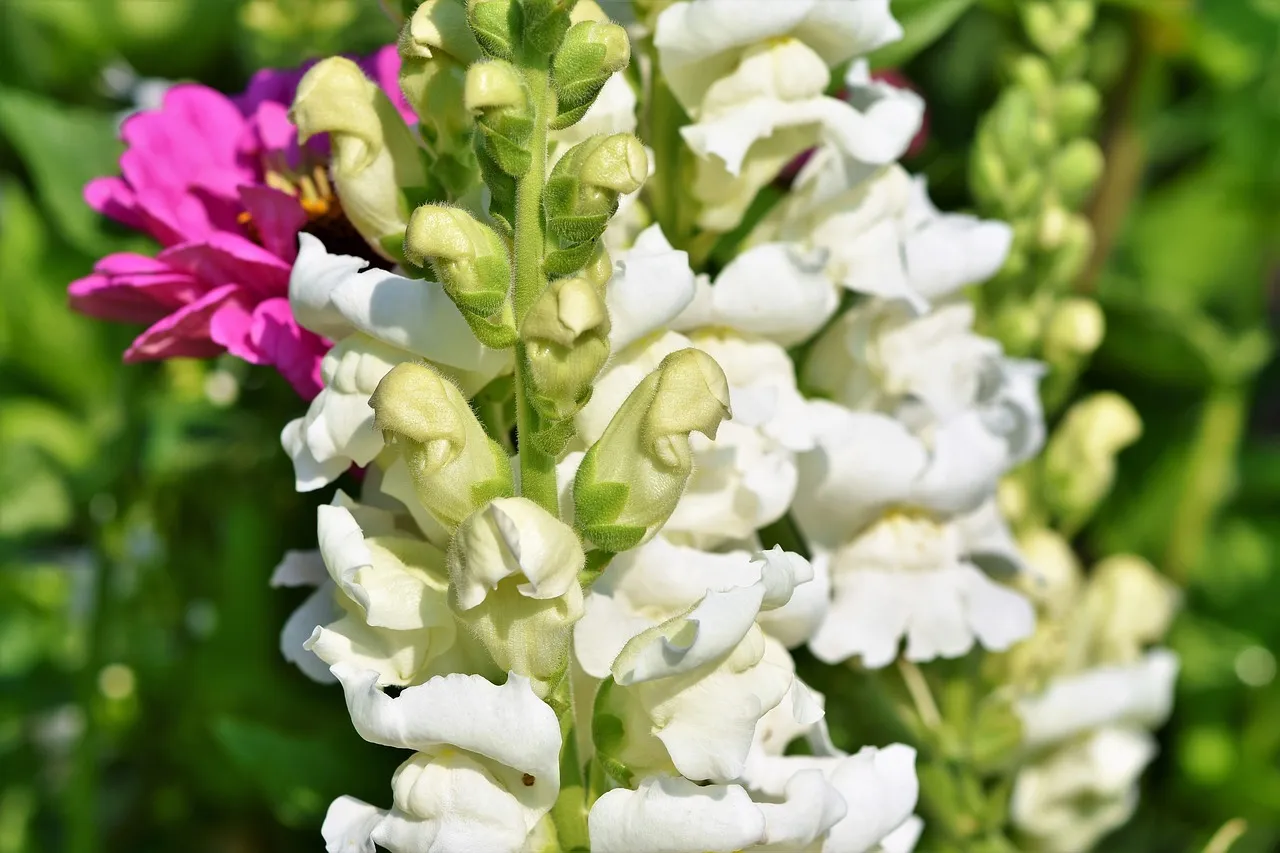
Antirrhinum charidemi (Charidemus’ Snapdragon):
The Antirrhinum charidemi, or Charidemus’ Snapdragon, is a unique and lesser-known variety that offers an intriguing addition to your balcony garden. With its slender, tubular blooms and striking burgundy hues, it stands out among other Snapdragons. This variety prefers full sun exposure and well-draining soil to prevent waterlogging.
Plant the seeds or transplants in early spring for the best results. Deadhead spent flowers to encourage continuous blooming and remove any faded or damaged foliage. Charidemus’ Snapdragon is relatively easy to care for, making it a delightful option for balcony gardeners seeking an extraordinary touch to their floral display.
Antirrhinum coulterianum (Coulter’s Snapdragon):
The Antirrhinum coulterianum, commonly known as Coulter’s Snapdragon, is a show-stopping variety that will captivate your balcony garden with its striking appearance. This species features tall flower spikes in vibrant shades of orange and red, adding a splash of warmth to your outdoor space. Coulter’s Snapdragon thrives in full sun and well-draining soil. Start seeds indoors early in spring and transplant the young plants when the weather is consistently warm.
Regular pruning and deadheading will help maintain its tidy appearance and promote continuous blooming. With its impressive color display and easy cultivation, Coulter’s Snapdragon is an excellent choice for balcony gardeners seeking a bold and vibrant floral centerpiece.
Antirrhinum glutinosum (Sticky Snapdragon):
The Antirrhinum glutinosum, also known as Sticky Snapdragon, is a delightful variety with its captivating blooms and sticky foliage. The flowers come in shades of yellow and orange, creating a cheerful and sunny atmosphere on your balcony. Sticky Snapdragon thrives in full sun and well-draining soil, making it suitable for sunny balconies with good drainage.
Sow the seeds or transplant young plants after the last frost date. Deadhead regularly to encourage continuous blooming and keep the plant looking neat and tidy. The Sticky Snapdragon is relatively low-maintenance and can tolerate drought conditions, making it a resilient addition to your balcony garden.
Antirrhinum hispanicum (Spanish Snapdragon):
The Antirrhinum hispanicum, commonly known as the Spanish Snapdragon, exudes old-world charm with its delicate blooms and vintage colors. This variety prefers partial shade and can tolerate cooler temperatures, making it an excellent option for balconies with varying light conditions. The Spanish Snapdragon requires well-draining soil to prevent waterlogging. Plant seeds or transplants in early spring or late summer for best results.
Regular deadheading will encourage a prolonged flowering period, and light pruning will help maintain its compact form. The Spanish Snapdragon’s unique charm and adaptability to varying light conditions make it a sought-after choice for balcony gardeners looking for a touch of vintage elegance.
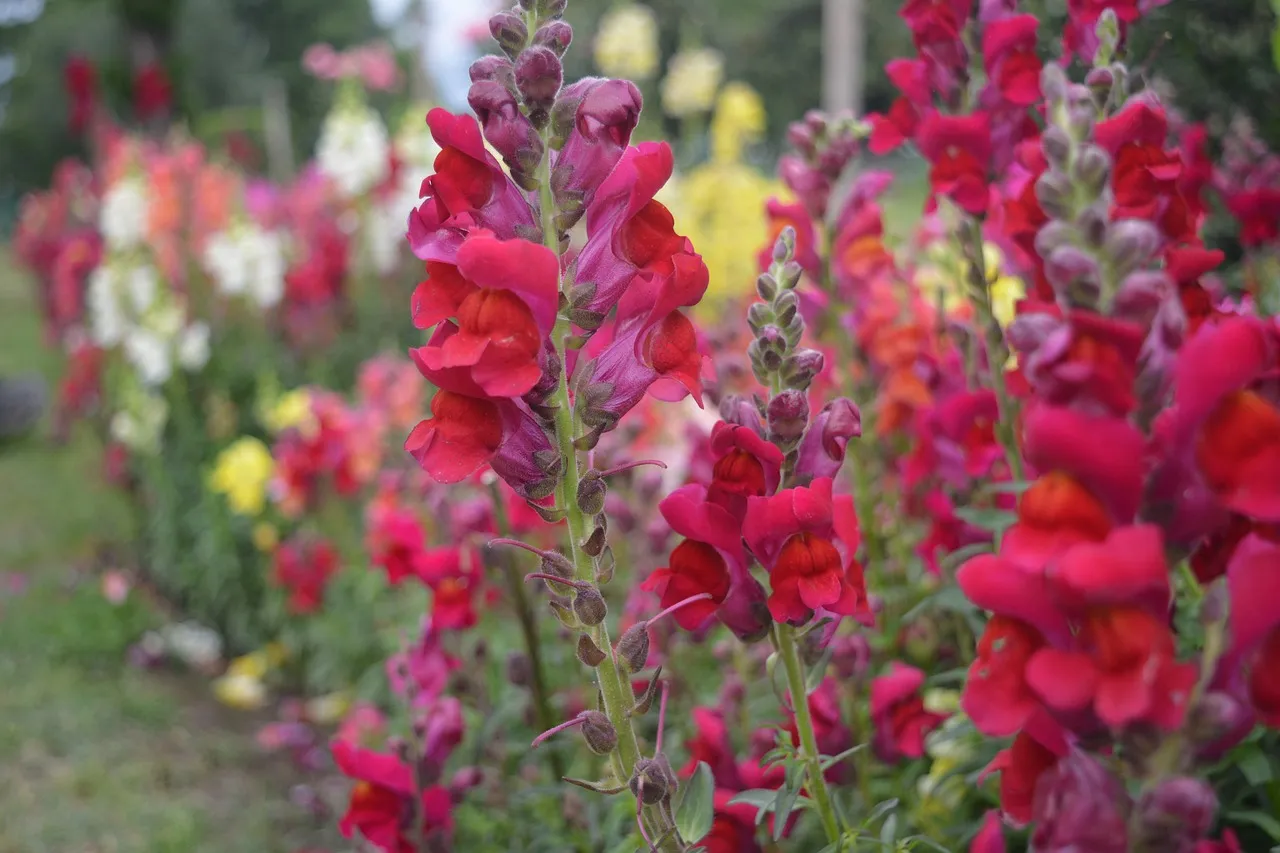
Antirrhinum latifolium (Broadleaf Snapdragon):
The Antirrhinum latifolium, also known as the Broadleaf Snapdragon, is a striking variety with its broad, glossy leaves and eye-catching flowers. This Snapdragon thrives in full sun and well-draining soil, making it ideal for sunny balconies with good drainage. Plant seeds or transplants in early spring or late summer for optimal growth.
Regular deadheading will encourage continuous blooming and keep the plant looking tidy. The Broadleaf Snapdragon is relatively low-maintenance and can tolerate drought conditions, making it a resilient addition to your balcony garden.
Antirrhinum linkianum (Link’s Snapdragon):
The Antirrhinum linkianum, commonly known as Link’s Snapdragon, is a charming variety with its petite size and delicate blooms. This Snapdragon prefers full sun exposure and well-draining soil. Start seeds indoors early in spring and transplant the young plants when the weather is consistently warm.
Regular pruning and deadheading will help maintain its compact form and encourage continuous blooming. Link’s Snapdragon is relatively easy to care for, making it a lovely option for balcony gardeners seeking a petite and elegant addition to their floral display.
Antirrhinum molle (Soft Snapdragon):

The Antirrhinum molle, or Soft Snapdragon, is a delightful variety that adds a touch of softness and charm to your balcony garden. This Snapdragon prefers partial shade and can tolerate cooler temperatures, making it a suitable option for balconies with varying light conditions. The Soft Snapdragon requires well-draining soil to prevent waterlogging.
Plant seeds or transplants in early spring or late summer for best results. Regular deadheading will encourage continuous blooming and keep the plant looking neat and tidy. The Soft Snapdragon’s gentle appearance and adaptability to varying light conditions make it a sought-after choice for balcony gardeners looking for a touch of grace and serenity.
Antirrhinum multiflorum (Many-flowered Snapdragon):
The Antirrhinum multiflorum, also known as Many-flowered Snapdragon, is a prolific bloomer that will fill your balcony with an abundance of colorful flowers. This variety thrives in full sun and well-draining soil, making it suitable for sunny balconies with good drainage. Sow the seeds or transplant young plants after the last frost date to kickstart their growth journey.
Regular deadheading will encourage continuous blooming and ensure a constant display of vibrant colors. The Many-flowered Snapdragon is relatively low-maintenance and can attract pollinators to your garden, enhancing overall biodiversity.
Antirrhinum oronense (Pyrenees Snapdragon):
The Antirrhinum oronense, commonly known as the Pyrenees Snapdragon, is a charming addition to any balcony garden. Native to the Pyrenees mountains, this variety is well-suited to cooler climates and can tolerate partial shade. The Pyrenees Snapdragon produces dainty flowers in soft pastel hues, creating a serene and peaceful ambiance. It requires well-draining soil and moderate watering to prevent waterlogging.
Plant the seeds or transplants in early spring or late summer for optimal growth. Deadhead spent blooms regularly to encourage new flower production. With its delicate beauty and adaptability to cooler conditions, the Pyrenees Snapdragon is an excellent choice for balcony gardeners looking to add a touch of mountain charm to their outdoor space.
Antirrhinum siculum (Sicilian Snapdragon):
The Antirrhinum siculum, commonly known as the Sicilian Snapdragon, is a unique and lesser-known variety that offers an intriguing addition to your balcony garden. With its slender, tubular blooms and striking burgundy hues, it stands out among other Snapdragons. This variety prefers full sun exposure and well-draining soil to prevent waterlogging. Plant the seeds or transplants in early spring for the best results.
Deadhead spent flowers to encourage continuous blooming and remove any faded or damaged foliage. The Sicilian Snapdragon is relatively easy to care for, making it a delightful option for balcony gardeners seeking an extraordinary touch to their floral display.
Antirrhinum subbaeticum (Subbaetic Snapdragon):

The Subbaetic Snapdragon, or Antirrhinum subbaeticum, captivates with unique flower spikes and vibrant colors. Thriving in full sun and well-draining soil, it suits sunny balconies with good drainage. Plant seeds or transplants in early spring or late summer for best growth. Regular pruning and deadheading ensure a tidy appearance and continuous blooming. This Snapdragon is low-maintenance and can tolerate drought, a resilient addition to your balcony garden.
Selecting the Perfect Balcony Spot:
When it comes to growing Snapdragon flowers on your balcony, the first crucial step is finding the perfect spot. Look for an area that receives ample sunlight throughout the day, as Snapdragons thrive in full sun. A minimum of 6 to 8 hours of direct sunlight is ideal for these vibrant blooms to reach their full potential. Additionally, consider protecting your Snapdragons from strong winds, as excessive wind can damage their delicate stems and flowers.
Choose a location that offers some form of windbreak, such as a wall or balcony railing, to shield your plants from gusts. By providing the right balance of sunlight and protection, you can create an ideal haven for your Snapdragons to flourish and dazzle your balcony garden with their beauty.
Soil Preparation and Amendments:

To ensure your Snapdragon flowers grow healthily and produce stunning blooms, it’s essential to focus on soil preparation and amendments. Start by selecting a high-quality potting mix with excellent drainage properties. Snapdragon plants dislike sitting in waterlogged soil, so good drainage is vital. You can also enhance the soil’s structure and nutrient content by adding organic amendments. Compost, well-rotted manure, or peat moss can improve the soil’s ability to retain moisture and nutrients, providing your Snapdragons with a fertile environment to thrive. Mixing these amendments into the potting mix before planting will give your Snapdragon flowers a head start in their growth journey, setting them up for success.
Starting from Seeds vs. Transplants:
Deciding whether to start your Snapdragon flowers from seeds or transplants is an important consideration. Both methods have their advantages and drawbacks, so understanding them will help you make an informed choice that aligns with your gardening preferences. Starting from seeds is more cost-effective and gives you access to a broader range of Snapdragon varieties.
However, it requires patience and careful nurturing as germination can take some time. On the other hand, transplants offer a head start, as you’ll be planting young Snapdragon plants that have already begun their growth journey. This approach is ideal if you want faster results or have missed the prime sowing time for seeds. Consider your time, resources, and gardening goals when deciding which method is best suited for you.
Watering Tips for Optimal Growth:
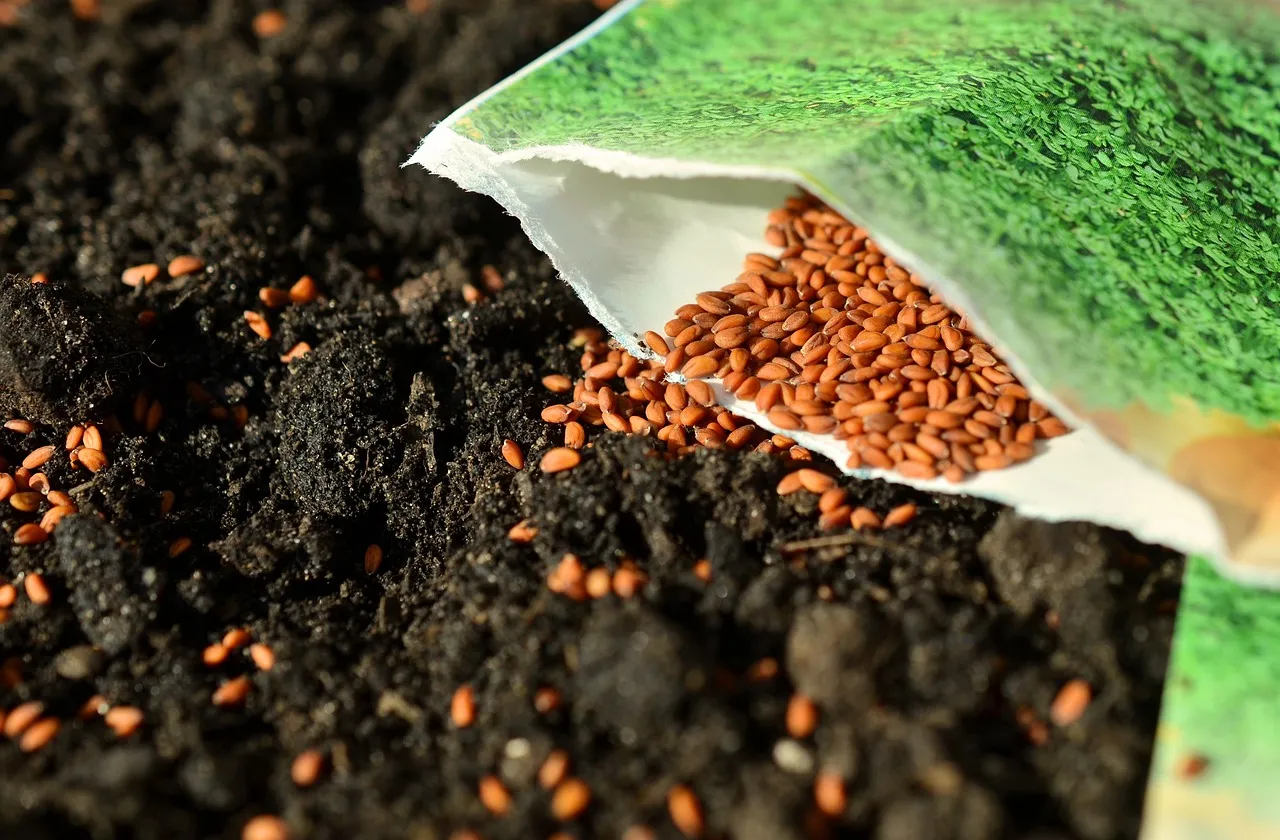
Proper watering is essential to ensure your Snapdragons grow optimally and maintain their health. To prevent underwatering or overwatering, which can harm your plants, follow some essential watering tips. The frequency of watering will depend on various factors, including the weather, the size of your containers, and the stage of growth. Generally, it’s best to water your Snapdragons when the top inch of soil feels dry to the touch. Use a watering can or a gentle spray nozzle to avoid damaging the delicate roots. Ensure that the water reaches the root zone without saturating the foliage excessively. Providing consistent and adequate moisture will keep your Snapdragons hydrated and encourage robust growth without risking root rot or water stress.
Fertilizing Strategies for Lush Blooms:
A well-planned fertilizing strategy can make a significant difference in the flower production and overall vitality of your Snapdragon plants. When choosing a fertilizer, opt for one with a balanced NPK ratio, which represents the three essential nutrients: nitrogen (N), phosphorus (P), and potassium (K). Nitrogen promotes healthy foliage growth, phosphorus aids in root development and flower production, while potassium enhances overall plant health and disease resistance.
During the growing season, apply a water-soluble, all-purpose fertilizer every two to four weeks, following the manufacturer’s instructions for dosage. Be cautious not to over-fertilize, as this can lead to excessive foliage growth at the expense of flowers. A well-fed Snapdragon will reward you with abundant, lush blooms that will brighten up your balcony garden.
Pruning and Deadheading Guide:
Mastering the art of pruning and deadheading is crucial to maintaining tidy and attractive Snapdragon plants throughout the growing season. Pruning involves removing spent flowers and stems to encourage new growth and prevent the plant from putting energy into producing seeds. Deadheading, on the other hand, focuses on removing only the faded or withered flowers. Regular deadheading will not only keep your Snapdragon plants looking neat but also promote continuous blooming.
Additionally, when pruning, cut the stem just above a set of leaves or nodes to encourage branching and a bushier growth habit. As the season progresses, you’ll notice that your Snapdragon plants remain vigorous, producing an abundance of new buds and blooms for a long-lasting display of color.
Dealing with Common Pests and Diseases:
While Snapdragon flowers are relatively resilient, they can still fall victim to certain pests and diseases. Identifying potential threats early and implementing preventive measures and natural remedies is crucial to keeping your plants healthy. Common pests that may target your Snapdragons include aphids, thrips, and spider mites. Keep an eye out for any signs of infestation, such as distorted leaves or tiny webs, and take action promptly. Insecticidal soaps or neem oil can be effective in controlling these pests without harming beneficial insects.
When it comes to diseases, Snapdragons may encounter issues such as powdery mildew or rust. Adequate spacing between plants, good air circulation, and avoiding overhead watering can help prevent these diseases. If necessary, use fungicides approved for ornamental plants to combat fungal infections. By staying vigilant and employing preventive measures, you can safeguard your Snapdragon flowers from common pests and diseases and ensure they thrive in a healthy environment.
Overwintering Snapdragons on Your Balcony:
As the colder months approach, you might be wondering how to protect your Snapdragon flowers and enjoy their beauty year after year. With some care and attention, it is possible to overwinter Snapdragons on your balcony successfully. Before the first frost, trim your Snapdragon plants back to a few inches above the soil line. Mulch around the base of the plants with a thick layer of straw or shredded leaves to insulate the roots from freezing temperatures.
If you experience particularly harsh winters, consider wrapping the containers with burlap or frost cloth to provide additional protection. On milder days, check the soil’s moisture level and water if it’s dry. Remember that Snapdragons are more sensitive to waterlogged soil during the dormant period. With these precautions in place, you can give your Snapdragons a fighting chance to survive the winter and come back stronger in the spring.
Creating Stunning Snapdragon Arrangements:
Your balcony-grown Snapdragons can serve as the perfect centerpiece for stunning floral arrangements. With their diverse colors and elegant spiky blooms, they blend beautifully with various other flowers and foliage. When creating arrangements, consider the shape, color, and texture of the flowers you choose to accompany your Snapdragons. For a vibrant and eye-catching display, pair Snapdragons with contrasting colors like vibrant yellows or soft pinks.
Delicate flowers like daisies or baby’s breath can complement the Snapdragon’s bold appearance, creating a balanced arrangement. Additionally, incorporate foliage with different textures to add depth and interest to the overall design. Don’t be afraid to experiment with various combinations until you find the perfect arrangement that showcases the beauty of your balcony-grown Snapdragons.
Attracting Pollinators to Your Balcony Garden:

The presence of pollinators is essential for the successful fertilization of your Snapdragon blooms. Bees, butterflies, and other pollinating insects play a vital role in transferring pollen from one flower to another, enabling the formation of seeds and fruits.
To attract these beneficial visitors to your balcony garden, incorporate pollinator-friendly plants alongside your Snapdragons. Flowers with simple, open blooms, such as marigolds, zinnias, and cosmos, are particularly appealing to pollinators. Include a variety of nectar-rich flowers that bloom at different times throughout the season to ensure a continuous food source for pollinators. Avoid using chemical pesticides, as they can harm pollinators and other beneficial insects. By creating a pollinator-friendly environment, you’ll not only help your Snapdragons thrive but also contribute to the conservation of these essential creatures.
Companion Planting for a Thriving Balcony Ecosystem:
Companion planting is an age-old gardening practice that involves planting different species together to benefit each other in various ways. By carefully selecting companion plants for your Snapdragon flowers, you can create a thriving balcony ecosystem that promotes growth and natural pest control. For instance, pairing Snapdragons with aromatic herbs like lavender or rosemary can help deter pests while providing a delightful fragrance. Tall, sturdy plants like sunflowers or foxgloves can serve as windbreaks and provide shade for your Snapdragons during scorching summer days.
Some companion plants also attract beneficial insects that prey on garden pests, further safeguarding your Snapdragon flowers. Embrace the art of companion planting to maximize your balcony garden’s potential and create a harmonious plant community that thrives together.
Seasonal Care and Planting Calendar:
To stay organized and ensure your Snapdragon garden flourishes throughout the year, keeping a seasonal care and planting calendar is essential. Begin by jotting down key dates, such as the average last frost date in your area, as Snapdragons prefer planting after the danger of frost has passed. Note the dates for planting seeds or transplanting young Snapdragon plants into your containers. As the growing season progresses, track the frequency and schedule of watering, fertilizing, and deadheading.
Keep an eye on the weather and adjust your care routine accordingly during particularly hot or rainy periods. A well-kept calendar will not only help you stay on top of your gardening tasks but also serve as a valuable reference for future years, allowing you to fine-tune your Snapdragon garden care with each passing season.
Creative DIY Containers for Snapdragons:
The containers you choose for your Snapdragon flowers can greatly impact the overall aesthetic and visual appeal of your balcony garden. Get creative and explore a variety of DIY container ideas to showcase your Snapdragon blooms in style. Repurposed items such as old wooden crates, vintage teapots, or colorful metal pails can add a charming and unique touch to your garden. Consider vertical gardening solutions like wall-mounted pallet planters or hanging baskets to maximize your space while adding a vertical dimension to your Snapdragon display.
To create a cohesive look, paint or decorate your containers to match your balcony’s theme or color scheme. By incorporating your personal flair into the container selection, you can transform your Snapdragon garden into a visually stunning and captivating space.
Propagation Techniques for Expanding Your Garden:
If you’re looking to expand your Snapdragon garden and share the beauty of these flowers with others, learning propagation techniques is essential. Propagation allows you to multiply your Snapdragon plants without the need to purchase additional seeds or transplants. The most common method of propagation for Snapdragons is through stem cuttings. To propagate from cuttings, select healthy stems and cut them just below a node using sharp, clean scissors.
Remove any leaves from the lower portion of the cutting to prevent excessive water loss. Soak the cut end in rooting hormone and plant in a pot with well-drained soil. Place the pot in a warm, bright location, and within a few weeks, roots should develop, giving rise to new Snapdragon plants. Propagation not only expands your Snapdragon garden but also presents an opportunity to share the joy of gardening with friends and family.
Harvesting Snapdragon Seeds for Next Season:
To ensure a bountiful supply of new Snapdragon plants for the next gardening season, harvesting and storing Snapdragon seeds properly is crucial. Allow some of your Snapdragon flowers to go to seed naturally, leaving the faded blooms on the plants until they dry out and turn brown. Once the seed pods are dry, carefully collect them and store them in a cool, dry place until you’re ready to sow them again. Label each seed packet with the variety name and the year of harvest to keep your seeds organized.
Properly stored Snapdragon seeds can remain viable for several years, ensuring you have a steady supply of seeds to replant and continue enjoying the beauty of these enchanting flowers. With a little planning and care, you can create a cycle of growth and beauty that perpetuates year after year.
Most Frequently Asked Questions on Snapdragon:
What is the best location on my balcony to grow Snapdragons?
When growing Snapdragons on your balcony, it’s essential to choose a spot that receives ample sunlight and is protected from strong winds. Look for an area with at least 6 to 8 hours of direct sunlight daily to ensure optimal growth and blooming. Additionally, consider placing your Snapdragon plants in a location shielded from strong winds, as excessive wind can damage their delicate stems and flowers. A spot with a wall or balcony railing acting as a windbreak can create an ideal haven for your Snapdragons to flourish.
What type of soil should I use for my Snapdragon plants?
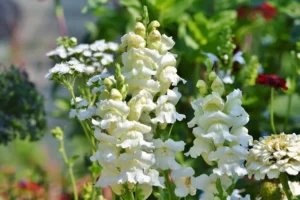
Snapdragons thrive in well-draining soil that prevents waterlogging. To create an ideal environment for your Snapdragon flowers, use a high-quality potting mix with good drainage properties. You can further enhance the soil’s structure and nutrient content by adding organic amendments like compost or well-rotted manure. These amendments will provide the necessary nutrients for healthy Snapdragon growth and help the soil retain moisture efficiently.
Should I start Snapdragons from seeds or transplants?
The choice between starting Snapdragons from seeds or transplants depends on your gardening preferences and time constraints. Starting from seeds is more cost-effective and allows access to a broader range of Snapdragon varieties. However, germination can take time and requires patience. On the other hand, transplants offer a head start, as you’ll be planting young Snapdragon plants that have already begun their growth journey. If you want faster results or missed the prime sowing time for seeds, transplants might be the better option for you.
How often should I water my Snapdragon plants?
Proper watering is crucial for the optimal growth and health of your Snapdragon plants. To prevent underwatering or overwatering, water your Snapdragons when the top inch of soil feels dry to the touch. Use a watering can or gentle spray nozzle to avoid damaging the delicate roots. Ensure the water reaches the root zone without saturating the foliage excessively. The frequency of watering will depend on factors like weather conditions, container size, and growth stage.
What fertilizing strategies should I use for lush Snapdragon blooms?
Fertilizing your Snapdragons can boost flower production and overall vitality. Use a balanced fertilizer with equal proportions of nitrogen (N), phosphorus (P), and potassium (K) to promote healthy foliage growth, root development, and overall plant health. Apply a water-soluble, all-purpose fertilizer every two to four weeks during the growing season, following the manufacturer’s instructions for dosage. Be cautious not to over-fertilize, as this can lead to excessive foliage growth at the expense of flowers.
How do I prune and deadhead my Snapdragon plants?
Pruning and deadheading are essential to maintain tidy and attractive Snapdragon plants. Deadhead spent flowers regularly to encourage continuous blooming and prevent the plant from putting energy into seed production. For pruning, cut the stem just above a set of leaves or nodes to encourage branching and a bushier growth habit. Regular pruning and deadheading will ensure your Snapdragons remain vigorous and produce an abundance of new buds and blooms.
How can I deal with common pests and diseases affecting Snapdragons?
Snapdragons can be vulnerable to certain pests and diseases. Identify potential threats early and implement preventive measures and natural remedies. The most common pests the gardener can witness like aphids, thrips and spider mites. Use insecticidal soaps or neem oil to control these pests without harming beneficial insects. For diseases like powdery mildew or rust, ensure adequate spacing between plants and good air circulation. Use approved fungicides if necessary, but try to avoid chemical treatments that can harm the environment.
How can I overwinter my Snapdragon plants on the balcony?
Protect your Snapdragon plants during colder months by trimming them back to a few inches above the soil line before the first frost. Mulch around the base of the plants with straw or shredded leaves for added insulation. In harsh winters, consider wrapping containers with burlap or frost cloth. Monitor soil moisture levels and water sparingly during the dormant period, as Snapdragons are more sensitive to waterlogged soil during this time.
What are some creative ways to arrange Snapdragon flowers?
Snapdragon flowers can serve as stunning centerpieces in floral arrangements. Pair them with contrasting colors like vibrant yellows or soft pinks to create eye-catching displays. Incorporate delicate flowers like daisies or baby’s breath for a balanced arrangement. Add foliage with varying textures to add depth and interest. Experiment with different combinations until you find the perfect arrangement that showcases the beauty of your balcony-grown Snapdragons.
How can I attract pollinators to my Snapdragon garden?
Attract pollinators to your garden by planting pollinator-friendly flowers alongside your Snapdragons. Flowers with simple, open blooms like marigolds and cosmos are particularly appealing to pollinators. Provide a variety of nectar-rich flowers that bloom at different times to ensure a continuous food source for pollinators. Avoid using chemical pesticides, as they can harm pollinators and other beneficial insects. Creating a pollinator-friendly environment will not only benefit your Snapdragons but also contribute to the conservation of these essential creatures.
What are some ideal companion plants for Snapdragons?
Companion planting is an effective way to create a thriving balcony ecosystem. Pair Snapdragons with aromatic herbs like lavender or rosemary to deter pests and provide fragrance. Tall, sturdy plants like sunflowers or foxgloves can serve as windbreaks and provide shade for your Snapdragons. Some companion plants also attract beneficial insects that prey on garden pests, safeguarding your Snapdragon flowers and other plants on the balcony. Embrace the art of companion planting to maximize your balcony garden’s potential and create a harmonious plant community that thrives together.
How can I stay organized with my Snapdragon garden care?
Maintain a seasonal care and planting calendar to stay organized with your Snapdragon garden care. Note key dates like the average last frost date and planting times for seeds or transplants. Track the frequency and schedule of watering, fertilizing, and deadheading throughout the growing season. Based on weather conditions, one need to adjust your care routine A well-kept calendar will serve as a valuable reference for future years, allowing you to fine-tune your Snapdragon garden care with each passing season.
How can I create DIY containers for my Snapdragon flowers?

Get creative with DIY container ideas to showcase your Snapdragon blooms in style. Repurpose items like wooden crates, vintage teapots, or colorful metal pails for a charming touch. Consider vertical gardening solutions like wall-mounted pallet planters or hanging baskets to maximize space. Paint or decorate your containers to match your balcony’s theme or color scheme. By incorporating your personal flair into the container selection, you can transform your Snapdragon garden into a visually stunning and captivating space.
How can I propagate Snapdragon plants to expand my garden?
Propagating Snapdragon plants multiplies your garden without buying more seeds or transplants. The common method is stem cuttings. Select healthy stems, cut below a node, and remove lower leaves. Soak the tip in rooting hormone and plant in well-drained potting soil. . Place the pot in a warm, bright location, and roots should develop in a few weeks. Propagation expands your garden and lets you share gardening joy with others.
How can I harvest Snapdragon seeds for next season?
Harvest Snapdragon seeds by allowing some flowers to go to seed naturally. Leave the faded blooms on the plants until they dry out and turn brown. Collect the dry seed pods and store them in a cool, dry place, labeled with the variety name and harvest year. Properly stored Snapdragon seeds can remain viable for several years, ensuring you have a steady supply to replant and continue enjoying the beauty of these enchanting flowers year after year.
SnapdragonFlowers #BalconyGarden #GardeningGuide”
